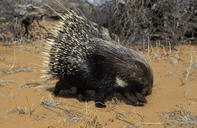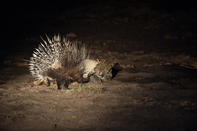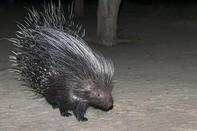Rattle and Roar
The Cape porcupine is the largest rodent in Southern Africa and is characteristically equipped with long, sharp quills, that are actually modified hairs, which it uses in defence against predators or other porcupine intruders.

Contrary to popular belief, porcupines do not shoot their quills out but rather, when threatened, they raise their quills, known as pilo-erection, and run backwards into the offender.
The quills pull free of the body easily and if the porcupine makes contact with the predator or if a predator takes a swipe or bite at the porcupine the quills may penetrate their skin deeply, sometimes causing fatally septic wounds. The end of the tail is modified into a rattle comprising hollow quills that produce a loud sound when shaken.
To put predators or intruders off, porcupines will rattle their tails and erect their quills menacingly, raise the crest of hair on the neck to appear bigger, stamp their feet and emit a low-pitched roar.
Mate Daily

Porcupines live in family groups comprising an adult male and female and their offspring from previous litters but only the adult pair within the group breeds. Breeding in porcupines is an understandably tricky task so it is remarkable that the monogamous pair actually mate daily.
The physical contact is necessary to stimulate the female’s ovarian cycle and while in the family group, other females are suppressed in this way and must disperse in order to have a chance at breeding. Copulation barely lasts a couple of minutes. The female moves her tail out of the way and backs into the male who stands on his hind legs.
In spite of the daily interaction the female only conceives once a year. Unlike other rodents, porcupine babies are born precocial with their eyes open, their incisor teeth and some spines fully erupted. The female suckles her young with teats positioned on her flanks so that she need not roll onto her quills. The young develop their defensive foot stamping and aggressive behaviour quickly.
Noisy and Destructive

Although porcupines live together, occupying disused aardvark burrows as their homesteads, they forage alone.
The adult male and female will initially escort youngsters and help defend them from predators but by five months old the young will forage alone too. Porcupines are predominantly vegetarians but they have extremely tough digestive systems and can process even poisonous materials like the bark of tamboti trees.
They regularly practice osteophagia, the chewing of bones, as they have high calcium requirements to maintain their coat of spiny quills and their large continuously growing incisor teeth. Bones are often found strewn around the sites where they den.
Porcupines are very noisy feeders and they are also very destructive feeders sometimes damaging more than they eat. They do play an ecological role in this regard ring-barking trees and contributing to the balance of woody and grass plants in the savanna system.
By Megan Emmett